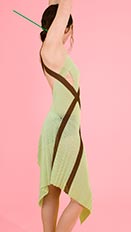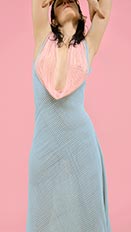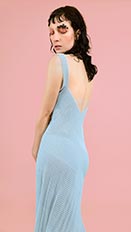modeclix
Wearable 3D printed garments
 The University of Hertfordshire has developed a revolutionary new prototype 3D printed textile and collection of wearable 3D printed garments and products.
The University of Hertfordshire has developed a revolutionary new prototype 3D printed textile and collection of wearable 3D printed garments and products.
The modeclix project is the latest leap forward for the fashion and product design industries as the project has successfully developed products that are uniquely customisable and wearable.
Shaun Borstrock, Associate Dean for Business and Innovation, is the architect behind the project, which has been created in collaboration with renowned 3D specialist and designer Professor Mark Bloomfield (electrobloom).
 Until now, more elaborate, sculptural couture 3D ‘prints’ have graced the catwalk for designers including Iris van Herpen, Chanel and Noa Raviv.
Until now, more elaborate, sculptural couture 3D ‘prints’ have graced the catwalk for designers including Iris van Herpen, Chanel and Noa Raviv.
One of the biggest challenges with 3D Printing technology to date has been how to make it wearable. This unique project addresses that challenge by ‘printing’ textiles that are flexible with movement and mimic traditional cloth.
The complex design process involved in making these revolutionary garments represents a huge breakthrough for garment technology and 3D printing.
 The project focuses on an interpretation of weave, stitch and knit. The initial prototypes are 3D printed as pieces of textile that have enough movement to ensure that they are fluid and represent a ‘fabric’ that can be used to make a garment.
The project focuses on an interpretation of weave, stitch and knit. The initial prototypes are 3D printed as pieces of textile that have enough movement to ensure that they are fluid and represent a ‘fabric’ that can be used to make a garment.
Featuring eight dresses and two headpieces this collection is the first to make 3D concepts wearable and can be customised to any size and shape either before printing or after, by adjusting the intricate links to fit by hand. They can also be dyed in an endless spectrum of thousands of colours.
Dr Shaun Borstrock, Associate Dean and Head of the Digital Hack Lab at the University of Hertfordshire, is collaborating with Professor Bloomfield on the project.
 'Previous 3D printed designs have been mostly conceptual pieces that are solid, with little or no movement. We have strived to create innovative 3D printed garments and products that have sufficient movement to ensure they are fluid, eye-catching and comfortable to wear and use. The products are made, dyed and finished by hand,' says Dr Borstrock.
'Previous 3D printed designs have been mostly conceptual pieces that are solid, with little or no movement. We have strived to create innovative 3D printed garments and products that have sufficient movement to ensure they are fluid, eye-catching and comfortable to wear and use. The products are made, dyed and finished by hand,' says Dr Borstrock.
'It will only be a matter of time before we see 3D collections on the high street and 3D printing technology in stores as part of everyday life. We’re pleased to be part of the movement that is exploring how this might become a reality.'
Professor Bloomfield, Managing Director of electrobloom commented, 'I’ve spent the last 25 years exploring how technology and 3D printing can enhance production techniques for jewellery and accessories, and this has been a fantastic opportunity to take this research even further. There is a huge amount of potential to develop complex construction techniques that defy traditional pattern cutting and create garments that are multi-functional, customisable and wearable.'
The collection will be available to view at digitalhacklab.herts.ac.uk and modeclix.com. It is also available to view in store at electrobloom, Studio 2.11, Oxo Tower Wharf, Bargehouse Street, London.
Photography – Agnes Lloyd Platt
